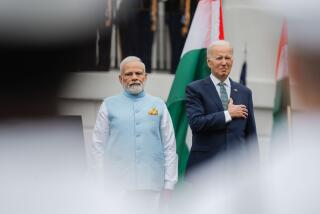A New Light on India : U.S. reassesses that nation as it transforms its economy in the post-Cold War era
- Share via
For most of the last half-century, the relationship between the United States and India was colored by Cold War distrust. Differences between the world’s two most populous democracies were frequent, with Washington voicing concern over India’s ties to the Soviet Union, its nonaligned status, its state-dominated economy and its nuclear weapons program. From a U.S. perspective, there was cause for suspicion, and that suspicion was the basis for a longstanding U.S. policy in South Asia that favored Pakistan, India’s neighbor and bitter rival.
Now, however, the Soviet Union is gone and India is making a revolutionary transformation from socialist protectionism to a market-oriented economy. In light of this and the fact that Pakistan now has nuclear weapons, the United States is being forced to reassess the Indo-American relationship.
Economic cooperation between the two nations is important. The United States already is India’s largest export market, and U.S. corporations like AT&T;, Ford, General Electric, Coca-Cola and IBM have operations in India. An enduring economic relationship appears certain. In a speech this month before a joint session of the U.S. Congress, Indian Prime Minister P. V. Narasimha Rao emphasized the new economic ties between Washington and New Delhi. For that matter, so has Ambassador-designate Frank Wisner, who will fill a 16-month vacancy and is expected to be confirmed when the Senate reconvenes after the Memorial Day holiday recess.
Such optimistic assessments are certainly welcome. But as the United States becomes more economically linked to India, it will be forced to face up to some uncomfortable differences that persist. These include India’s continuing attempt to develop nuclear weapons and its efforts, much criticized by human rights groups, to crush a separatist insurrection in Kashmir. The violence in Kashmir reportedly has claimed as many as 20,000 lives.
Although the United States and India can easily agree on the benefits of a stronger economic relationship, they aren’t likely to find the going smooth as they confront the political challenges.
More to Read
Sign up for Essential California
The most important California stories and recommendations in your inbox every morning.
You may occasionally receive promotional content from the Los Angeles Times.













